Galanz 10025001 Microwave Oven User Manual
Guangdong Galanz Enterprises Co., Ltd. Microwave Oven
Galanz >
User Manual
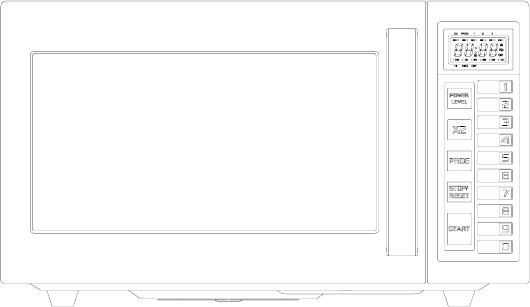
Model: P100M25ASL-5S
Microwave Oven User's manual
Please read these instructions carefully before installing and operating the oven.
Record in the space below the SERIAL NO. found on the nameplate on your oven and retain
this information for future reference.
SERIAL NO.
Please save sales receipt for warranty.
This equipment generates, uses and can radiate radio frequency energy and, if not
installed and used in accordance with the instructions, may cause harmful
interference to radio communications. However, there is no guarantee that
interference will not occur in a particular installation. If this equipment does
cause harmful interference to radio or television reception, which can be
determined by turning the equipment off and on, the user is encouraged to try to
correct the interference by one or more of the following measures:
• Reorient or relocate the receiving antenna.
• Increase the separation between the equipment and receiver.
• Connect the equipment into an outlet on a circuit different from that to which the
receiver is connected.
• Consult the dealer or an experienced radio/TV technician for help

1
1. Do not attempt to operate this oven with the door-open since open-door operation can
result in harmful exposure to microwave energy. It is important not to defeat or tamper
with the safety interlocks.
2. Do not place any object between the oven front face and the door or allow soil or
cleaner residue to accumulate on sealing surfaces.
3. Do not operate the oven if it is damaged. It is particularly important that the oven door
close properly and that there is no damage to the:
a. Door (bent),
b. Hinges and latches (broken or loosened),
c. Door seals and sealing surfaces.
4. The oven should not be adjusted or repaired by anyone except properly qualified
service personnel.
5.
CONTENT
PRECAUTIONS TO AVOID POSSIBLE EXPOSURE TO EXCESSIVE MICROWAVE
ENERGY ...............................................................................................................................1
IMPORTANT SAFETY INSTRUCTIONS...............................................................................2
INSTALLATION GUIDE.........................................................................................................3
GROUNDING INSTRUCTIONS............................................................................................3
UTENSILS GUIDE ................................................................................................................4
COOKING TECHNIQUES.....................................................................................................5
SPECIFICATIONS.................................................................................................................6
PART NAMES .......................................................................................................................6
CONTROL PANEL ................................................................................................................7
HOW TO SET THE OVEN CONTROLS ...............................................................................8
Time and power level cooking.......................................................................................8
Save a cooking to a number key...................................................................................8
X2 storage of cooking programs ...................................................................................9
Count of operation.........................................................................................................9
Child lock.......................................................................................................................9
Helpful instructions................................................................................................................9
Defrosting frozen foods .................................................................................................9
For best results............................................................................................................10
For even finished cooking ...........................................................................................10
Important recommendations........................................................................................10
Microwave basics........................................................................................................11
CLEANING AND CARE.......................................................................................................11
P
PR
RE
EC
CA
AU
UT
TI
IO
ON
NS
S
T
TO
O
A
AV
VO
OI
ID
D
P
PO
OS
SS
SI
IB
BL
LE
E
E
EX
XP
PO
OS
SU
UR
RE
E
T
TO
O
E
EX
XC
CE
ES
SS
SI
IV
VE
E
M
MI
IC
CR
RO
OW
WA
AV
VE
E
E
EN
NE
ER
RG
GY
Y

SAVE THESE INSTRUCTIONS
2
When using electrical appliances, basic safety
precautions should be followed, including the
following:
WARNING - To reduce the risk of burns, electric
shock, fire, injury to persons or exposure to
excessive microwave energy:
1. Read all instructions before using the
appliance.
2. Read and follow the specific "PRECAUTIONS
TO AVOID POSSIBLE EXPOSURE TO
EXCESSIVE MICROWAVE ENERGY" on
page 1.
3. This appliance must be grounded. Connect
only to properly grounded outlet. See
"grounding instructions " on page 3.
4. Install or locate this appliance only in
accordance with the provided installation
instructions.
5. Some products such as whole eggs and
sealed containers -for example, closed glass
jars- are able to explode and should not be
heated in this oven.
6. Use this appliance only for its intended use as
described in this manual. Do not use
corrosive chemicals or vapors in this
appliance. This type of oven is specifically
designed to heat, cook, or dry food.
7. As with any appliance, close supervision is
necessary when used by children.
8. To reduce the risk of fire in the oven cavity:
a. Do not overcook food. Carefully attend
appliance when paper, plastic, or other
combustible materials are placed inside the
oven to facilitate cooking.
b. Remove wire twist-ties from paper or plastic
bags before placing bag in oven.
c. If materials inside the oven should ignite,
keep oven door closed, turn oven off, and
disconnect the power cord or shut off power
at the fuse or circuit breaker panel.
d. Do not use the cavity for storage purposes.
Do not leave paper products, cooking
utensils or food in the cavity when not in use.
9. Liquids, such as water, coffee, or tea are able
to be overheated beyond the boiling point
without appearing to be boiling due to surface
tension of the liquid. Visible bubbling or
boiling when the container is removed from
the microwave oven is not always present.
THEIS COULD RESULT IN VERY HOT
LIQUIDS SUDDENLY BOILING OVER WHEN
A SPOON OR OTHER UTENSIL IS
INSERTED INTO THE LIQUID. To reduce the
risk of injury to person:
a. Do not overheat the liquid.
b. Stir the liquid both before and halfway
through heating it.
c. Do not use straight-sided containers with
narrow necks.
d. After heating, allow the container to stand in
the microwave oven for a short time before
removing the container.
e. Use extreme care when inserting a spoon or
other utensil into the container.
10. Do not heat oil or fat for deep-frying. It is
difficult to control the temperature of oil in
microwave oven.
11. Pierce foods with heavy skins such as
potatoes, whole squash, apples and
chestnuts before cooking.
12. The contents of feeding bottles and baby jars
should be stirred or shaken and the
temperature should be checked before
serving in order to avoid burns.
13. Cooking utensils may become hot because of
heat transferred from the heated food.
Potholders may be needed to handle the
utensil.
14. Do not cover or block any openings on the
appliance.
15. Do not store or use this appliance outdoors.
Do not use this product near water, for
example, near a kitchen sink, in a wet
basement, near a swimming pool, or similar
locations.
16. Do not operate this appliance if it has a
damaged cord or a plug, if it is not working
properly or if it has been damaged or
dropped.
17. Do not immerse cord or plug in water. Keep
cord away from heated surface. Do not let
cord hang over edge of table or counter.
I
IM
MP
PO
OR
RT
TA
AN
NT
T
S
SA
AF
FE
ET
TY
Y
I
IN
NS
ST
TR
RU
UC
CT
TI
IO
ON
NS
S
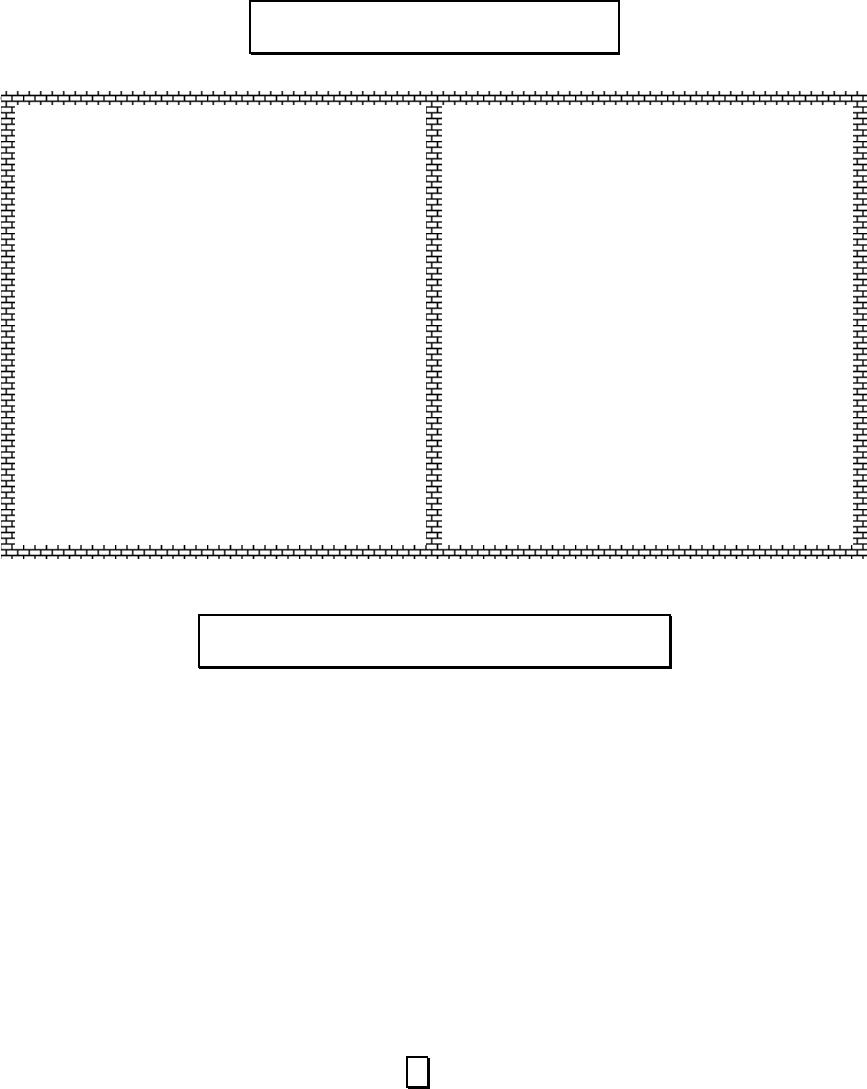
SAVE THESE INSTRUCTIONS
3
18. Use only thermometers, which are specifically
designed for use in microwave ovens.
19. Do not operate any heating or cooking
appliance beneath this appliance.
20. This appliance should be serviced only by
qualified service personnel, contact nearest
authorized service facility for examination,
repair, or adjustment.
21. When cleaning surfaces of door and oven that
comes together on closing the door, use only
mild, nonabrasive soaps, or detergents
applied with a sponge or soft clot
This appliance must be grounded. In the event
of an electrical short circuit, grounding reduces
risk of electric shock by providing an escape
wire for the electric current.
WARNING Improper use of the grounding plug
can result in a risk of electric shock.
ELECTRICAL REQUIREMENTS
The electrical requirements are a 120 volt 60
Hz, AC only, 20 amp. It is recommended that a
separate circuit serving only the oven be
provided. The oven is equipped with a 3-prong
grounding plug. It must be plugged into a wall
receptacle that is properly installed and
grounded.
Power Supply Cord
1. A short power supply cord is provided to
reduce the risks resulting from becoming
entangled in or tripping over a longer cord.
2. Longer cord sets or extension cords are
I
IN
NS
ST
TA
AL
LL
LA
AT
TI
IO
ON
N
G
GU
UI
ID
DE
E
G
GR
RO
OU
UN
ND
DI
IN
NG
G
I
IN
NS
ST
TR
RU
UC
CT
TI
IO
ON
NS
S
1. Make sure that all the packing materials
are removed from the inside of the door.
2. Check the oven for any damage, such
as misaligned or bent door, damaged
door seals and sealing surface, broken
or loose door hinges and latches and
dents inside the cavity or on the door. If
there is any damage, do not operate the
oven but contact qualified service
personnel.
3. This microwave oven must be placed
on a flat, stable surface to hold its
weight and the heaviest food likely to be
cooked in the oven.
4. Do not place the oven where heat,
moisture, or high humidity are
generated, or near combustible
materials.
5. For correct operation, the oven must
have sufficient airflow. Allow 20cm of
space above the oven, 10cm at back
and 5cm at both sides. Do not cover or
block any openings on the appliance.
Do not remove feet on which oven
stands.
6. Make sure that the power supply cord is
undamaged and does not run under the
oven or over any hot or sharp surface.
7. The socket must be readily accessible
so that it can be easily unplugged in an
emergency.

4
available and may be used if care is
exercised in their use.
3. If long cord or extension cord is used:
a) The marked electrical rating of the cord
set or extension cord should be at least
as great as the electrical rating of the
appliance.
b) The extension cord must be a
grounding-type 3-wire cord, and The
longer cord should be arranged so that
it will not drape over the counter top or
table top where it can be pulled on by
children or tripped over unintentionally.
Notes:
If you have any questions about the grounding
or electrical instructions, consult a qualified
electrician or service person.
Neither Galanz nor the dealer can accept any
liability for damage to the oven or personal
injury resulting from failure to observe the
electrical connection procedures.
This section lists which utensils can be used in
the microwave, which ones have limited use for
short periods, and which ones should not be
used in the microwave.
9 RECOMMENDED
Microwave browning dish — Use to brown
the exterior of small items such as steaks,
chops, or pancakes. Follow the directions
provided with your browning dish.
Microwaveable plastic wrap — Use to retain
steam. Leave a small opening for some steam
to escape and avoid placing it directly on the
food.
Paper towels and napkins — Use for
short-term heating and covering; these absorb
excess moisture and prevent spattering. Do not
use recycled paper towels, which may contain
metal and could ignite.
Glass and glass-ceramic bowls and dishes
— Use for heating or cooking.
Paper plates and cups — Use for short-term
heating at low temperatures. Do not use
recycled paper, which may contain metal and
could ignite.
Wax paper — Use as a cover to prevent
spattering.
Thermometers — Use only those labeled
"Microwave Safe" and follow all directions.
Check the food in several places. Conventional
thermometers may be used on microwave food
once the food has been removed from the
oven.
Λ
LIMITED USE
Aluminum foil — Use narrow strips of foil to
prevent overcooking of exposed areas. Using
too much foil can damage your oven, so be
careful. You should keep distance of 1 inch
(2.54cm) between aluminum foil and cavity.
Ceramic, porcelain, and stoneware— Use
these if they are labeled "Microwave Safe". If
they are not labeled, test them to make sure
they can be used safely.
Plastic — Use only if labeled "Microwave
Safe". Other plastics can melt.
8
Not Recommended
U
UT
TE
EN
NS
SI
IL
LS
S
G
GU
UI
ID
DE
E

5
Glass jars and bottles — Regular glass is too
thin to be used in a microwave. It can shatter
and cause damage and injury.
Paper bags — These are a fire hazard, except
for popcorn bags that are designed for
microwave use.
Styrofoam plates and cups — These can
melt and leave an unhealthy residue on food.
Plastic storage and food containers —
Containers such as margarine tubs can melt in
the microwave.
Metal utensils — These can damage your oven.
Remove all metal before cooking.
Note:
Should you wish to check if a dish is safe for
microwaving, place the empty dish in the oven
and microwave on HIGH for 30 seconds. A dish
which becomes very hot should not be used.
Your microwave makes cooking easier than
conventional cooking, provided you keep these
considerations in mind:
STIRRING
Stir foods such as casseroles and vegetables
while cooking to distribute heat evenly. Food at
the outside of the dish absorbs more energy
and heats more quickly, so stir from the outside
to the center. The oven will turn off when you
open the door to stir your food.
ARRANGEMENT
Arrange unevenly shaped foods, such as
chicken pieces or chops, with the thicker,
meatier parts toward the outside of the
turntable where they receive more microwave
energy. To prevent overcooking, place delicate
areas, such as asparagus tips, toward the
center of the turntable.
SHIELDING
Shield food with narrow strips of aluminum foil
to prevent overcooking. Areas that need
shielding include poultry wing tips, the ends of
poultry legs, and corners of square baking
dishes. Use only small amounts of aluminum
foil. Larger amounts can damage your oven.
TURNING
Turn foods over midway through cooking to
expose all parts to microwave energy. This is
especially important with large foods such as
roasts.
STANDING
Foods cooked in the microwave build up
internal heat and continue to cook for a few
minutes after heating stops. Let foods stand to
complete cooking, especially foods such as
cakes and whole vegetables. Roasts need this
time to complete cooking in the center without
overcooking the outer areas. All liquids, such
as soup or hot chocolate, should be shaken or
stirred when cooking is complete. Let liquids
stand a moment before serving. When heating
baby food, stir well at removal and test the
temperature before serving.
C
CO
OO
OK
KI
IN
NG
G
T
TE
EC
CH
HN
NI
IQ
QU
UE
ES
S
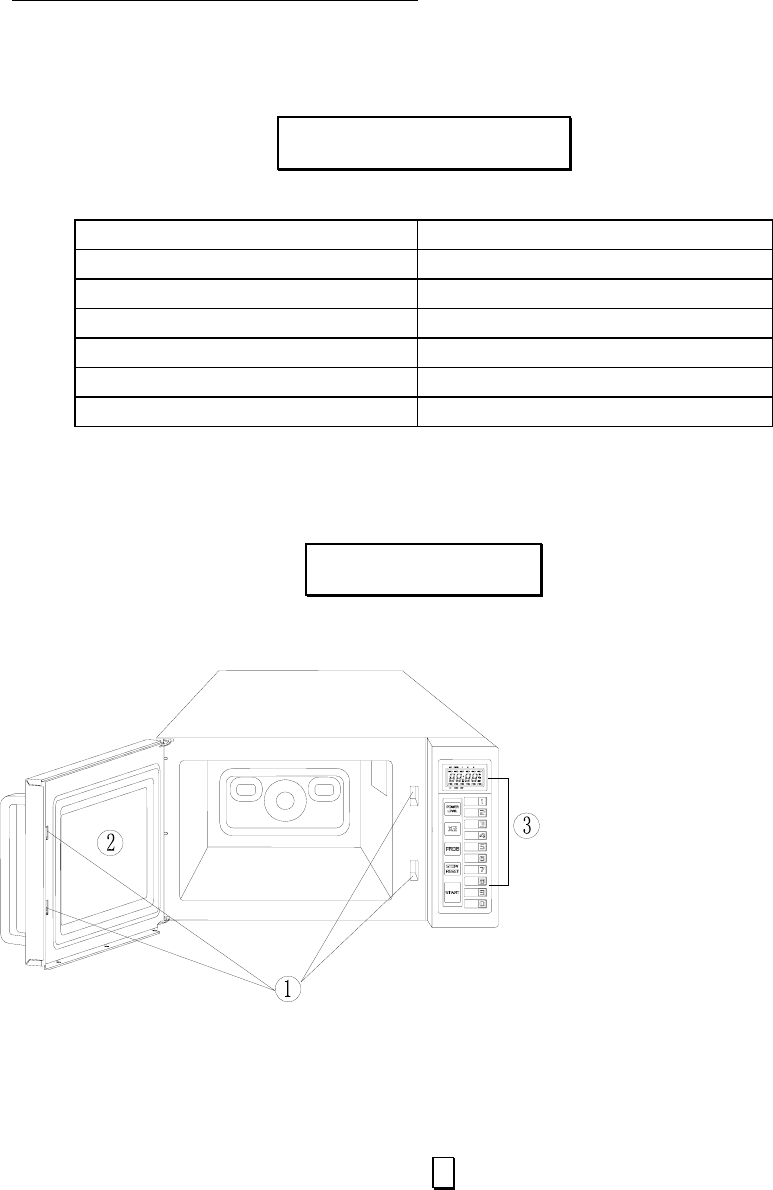
6
ADDING MOISTURE
Microwave energy is attracted to water
molecules. Food that is uneven in moisture
content should be covered or allowed to stand
so that the heat disperses evenly. Add a small
amount of water to dry food to help it cook.
Power Consumption: 120V~60Hz, 1450W (MICROWAVE)
Output: 1000W
Operation Frequency: 2450MHz
Outside Dimensions(H×W×D): 12.3 inch×20.5 inch×17.4 inch
Oven Cavity Dimensions(H×W×D): 8.3 inch×13.2 inch×14.3 inch
Oven Capacity: 0.7cu.ft
Net Weight: Approx. 38.9lb.
The above quoted subject to change without further notice.
1. Door Safety Lock
System
2. Oven Window
3. Control Panel
S
SP
PE
EC
CI
IF
FI
IC
CA
AT
TI
IO
ON
NS
S
P
PA
AR
RT
T
N
NA
AM
ME
ES
S
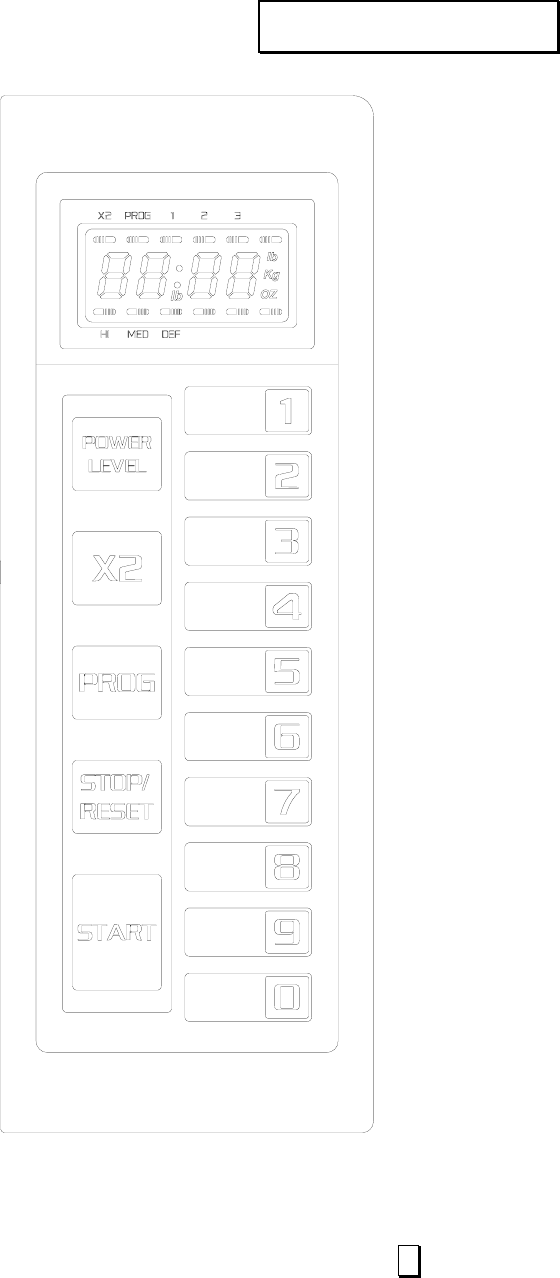
7
Q MENU ACTION SCREEN
Ú Cooking time, power, action indicators are
displayed.
Q NUMBER PADS
Ú Used to set cooking time and store multiple
cooking programs.
Q POWER LEVEL
Ú Press this button once or repeatedly to set a
cooking power level.
Q X2
Ú This pad is used to save a cooking program
to a number key and recall it later
conveniently.
Q PROG
Ú Used when setting a cooking program and
saving it to a number key.
Q STOP/RESET
Ú During cooking, press once to temporarily
stop cooking, press twice to cancel the
cooking program.
Q START
Ú Touch to start a cooking program.
Please read the following pages for more detail.
C
CO
ON
NT
TR
RO
OL
L
P
PA
AN
NE
EL
L
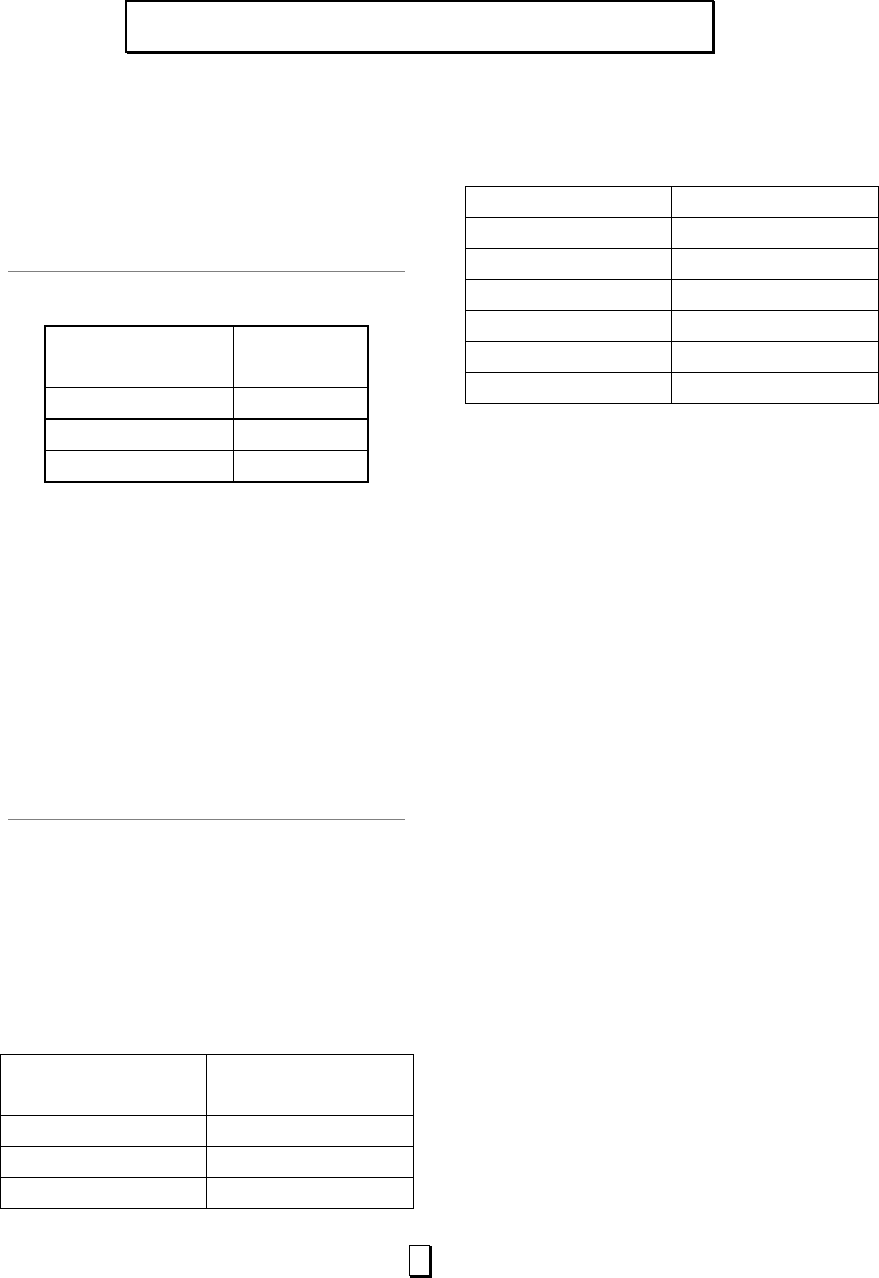
8
After the oven is plugged in, beeping and blue background light indicates the oven is in waiting for input
mode.
TIME AND POWER LEVEL COOKING
Three microwave cooking power levels can be
selected by touching the POWER LEVEL pad.
Touch
POWER LEVEL
Power
Description
Once HI
Twice MED
Thrice DEF
Take the following steps to set a cooking
program:
1. Touch POWER LEVEL to select cooking
power level.
2. Touch Number Pads to set cooking time
maximum 99min. 99 sec.
3. Touch START.
SAVE A COOKING TO A NUMBER KEY
For frequently used cooking program, you can
save it to a number key and conveniently
activate it by touching the number key.
Each of the number keys is pre-set with a
cooking program. In waiting mode, touch any
of the ten number pads, you are selecting a
cooking program.
The following is default settings for each of the
number keys
Touch
NUMBER PADS
PRESET COOKING
TIME
1 :10
2 :20
3 :30
4 :45
5 1:00
6 1:30
7 2:00
8 2:30
9 3:00
0 3:30
The user is free to reset the cooking program
stored under each of the ten number keys
anytime. In order to set a cooking program,
which may contain up to 3 stages consecutive
cooking periods with different power levels,
and to designate a number key to this
program, take the following steps
For example: to set a cooking program and
save it to number key 1.
1. In waiting mode, press PROG key once.
2. Press number pad 1.
3. Press POWER LEVEL a number of times
to set cooking power.
4. Touch number keys to set cooking time.
5. Press PROG to save.
You can set a two or three stages cooking
program by repeating the steps 3-4 once or
twice. After finished, press START, the screen
will display the total time.
Note: If you want the oven to start after you
touching the START pad instead of
immediately after you touching any of the
number keys, press and hold down
STOP/RESET for 5 sec; now you have to
press START pad after selecting a cooking
program by touching any of the number keys.
H
HO
OW
W
T
TO
O
S
SE
ET
T
T
TH
HE
E
O
OV
VE
EN
N
C
CO
ON
NT
TR
RO
OL
LS
S
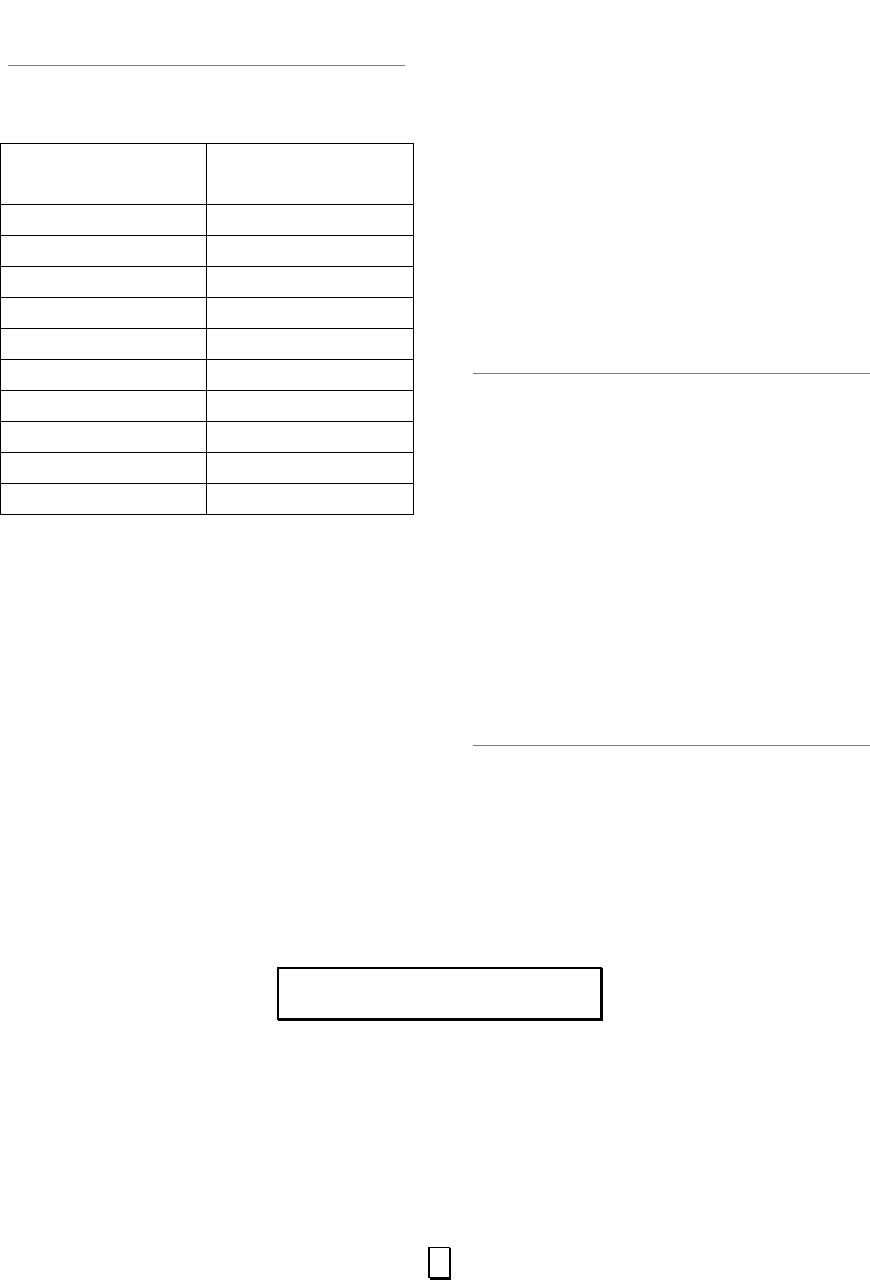
9
X2 STORAGE OF COOKING PROGRAMS
In waiting mode, press X2 and then any of the
number keys, you can recall a preset cooking
program as follows:
Touch
NUMBER PADS
PRESET COOKING
TIME
1 :20
2 :40
3 1:00
4 1:30
5 2:00
6 3:00
7 4:00
8 5:00
9 6:00
0 7:00
To reset the existing programs,
1. Press PROG key once.
2. Press X2 once
3. Press any of the number keys.
4. Press POWER LEVEL a number of times
to select cooking power.
5. Touch the number keys to enter cooking
time.
6. Press PROG to save.
X2 function can only program one stage
cooking. After setting is finished, press
STOP/RESET to return to waiting mode.
The oven will start after you touching X2 and
then any of the number keys.
Note: If you want the oven to start after you
touching the START pad instead of
immediately after you touching any of the
number keys. Press and hold down
STOP/RESET for 5 sec; now you have to
press START pad after selecting a cooking
program by touching X2 and any of the
number keys.
COUNT OF OPERATION
You can read the count of how many times the
oven has been used. To do this,
1. Open the door.
2. Press and hold down STOP/RESET and
then touch POWER LEVEL pad. The
number on display shows how many
times the oven has been used.
This function is for the user to analyze the
usage of the oven and the traffic flow at a
particular location where the oven is being
used commercially.
CHILD LOCK
In waiting mode, press and hold PROG for 5
seconds. The oven is locked.
To release child lock,
In waiting mode, press and hold PROG for 5
seconds, the oven goes to normal
DEFROSTING FROZEN FOODS
1. If you try to completely defrost frozen foods in the microwave oven, uneven defrosting may occur
due to the differences in the thickness and shape of the food. Drippings may also result, and
H
He
el
lp
pf
fu
ul
l
i
in
ns
st
tr
ru
uc
ct
ti
io
on
ns
s

10
sometimes a part of the food cooks although other parts still remain frozen. In actual usage of
frozen foods, you should not normally completely defrost food, but 70% defrosting in the oven is
quite good for the next step of preparing the food for cooking.
2. To defrost evenly, turn over or rearrange the food during defrosting.
3. To defrost fatty meat, heat for a short time in the oven and leave it to stand at room temperature,
or heat it intermittently until defrosted.
4. When you defrost a whole chicken, or any frozen food of irregular shape, wrap legs or thin parts
with aluminum foil. Otherwise thin parts will be defrosted faster and sometimes cooked before
other parts have properly defrosted. For big pieces of meat, wrap the sides with aluminum foil so
that they will be uniformly thawed by vertical microwaves only.
5. Ice should be removed at times during defrosting.
FOR BEST RESULTS
1. when determining time for particular foods, always figure minimum time and check occasionally
during cooking for progress. The microwave oven cooks so quickly, therefore it is easy to
overcook your foods.
2. Be careful of the cooking time for small quantities of foods, or foods with low water content. They
may burn if cooked too long.
3. Do not use the oven for drying kitchen towels or napkins. They may burn if heated too long.
4. Do not try to boil eggs in the oven.
5. When you cook an egg, be sure to pierce the yolk membrane prior to placing into the oven to
prevent the egg bursting.
FOR EVEN FINISHED COOKING
Open the door and give the dish a half turn, or turn the food over during cooking. This helps to
achieve more even cooking. When you cook chicken the legs cook faster than other parts. Wrap the
legs with aluminum foil during cooking to reflect the microwave energy in order to create even
cooking.
IMPORTANT RECOMMENDATIONS
Cooking should be done only with the microwave safe vessels; we cannot use steel or any other
vessel.
1. Temperature of foods. ---for best results it is recommended that foods conventionally prepared be
slightly undercooked when subsequently heated in this oven.
2. Remember that after the heating cycle has been completed, internal food temperatures continue
to rise slightly in foods heated in this oven.
3. A major abuse of microwave applications is the category of breads, pastries and pies are drier
than insides or fillings, they heat more slowly. Therefore, baked foods should only be heated until
the crust is warm to the touch (45℃-55℃).
4. Do not overheat your food: 99% of all food quantity complaints of microwave-heated foods can be

11
traced to overheating.
MICROWAVE BASICS
A number of factors determine the success of microwave food preparation. They include:
1. Temperature of foods: frozen or refrigerated food items require longer heating times to reach a
desired serving temperature than foods from room temperature.
2. Food components: foods high in sugar, salt, fats and moisture content heat faster because these
properties attract microwave energy. Denser foods high in protein and fiber, absorb microwave
energy slower which means a lengthier heating time.
3. Bulk/volume: the greater the mass of food, the longer it takes to heat.
4. Containers: ceramic, paper, china, Styrofoam, glass and plastic are suitable for use in microwave
ovens with the following caution. Heating foods with either high sugar or high fat content should
be done only in high temperature resistant containers since these foods get very hot. Using
Styrofoam containers for these foods with cause the Styrofoam to warp. Other low temperature
restaurant glass or plastic platters may crack or warp under similar conditions. Do not heat food in
a sealed container or bag. Foods expand when heated and can break the container or bag.
5. Avoid metal: because it bounces the microwaves, causing uneven heating and sometimes even
flashes, which may pit or mar the interior of the oven, the metal container or plate trim.
6. Heated liquids can erupt if not mixed with air. Do not heat liquids in your microwave oven without
first stirring.
1. Turn off the oven and remove the power
plug from the wall socket before cleaning.
2. Keep the inside of the oven clean. When
food splatters or spilled liquids adhere to
oven walls, wipe with a damp cloth. Mild
detergent may be used if the oven gets
very dirty. Avoid the use of spray and other
harsh cleaners as they may stain, streak
or dull the door surface.
3. The outside surfaces should be cleaned
with a damp cloth. To prevent damage to
the operating parts inside the oven, water
should not be allowed to seep into the
ventilation openings.
4. Wipe the window on both sides with a
damp cloth to remove any spills or
spatters.
5. Do not allow the control panel to become
wet. Clean with a soft, damp cloth. When
cleaning the control panel, leave oven
door open to prevent oven from
accidentally turning on.
6. If steam accumulates inside or around the
outside of the oven door, wipe with a soft
cloth. This may occur when the microwave
oven is operated under high humidity
conditions. In such case, it is normal.
7. The roller ring and oven floor should be
cleaned regularly to avoid excessive noise.
Simply wipe the bottom surface of the
oven with mild detergent. The roller ring
may be washed in mild sudsy water or
C
CL
LE
EA
AN
NI
IN
NG
G
A
AN
ND
D
C
CA
AR
RE
E

12
dishwasher. When removing the roller ring
from cavity floor for cleaning, be sure to
replace in the proper position.
8. Remove odors from your oven by
combining a cup of water with the juice
and skin of one lemon in a deep
microwaveable bowl, microwave for 5
minutes. Wipe thoroughly and dry with a
soft cloth.
9. When it becomes necessary to replace the
oven light, please consult a dealer to have
it replaced.
10. The oven should be cleaned regularly and
any food deposits removed. Failure to
maintain the oven in a clean condition
could lead to deterioration of the surface
that could adversely affect the life of the
appliance and possibly result in a
hazardous situation.
11. Please do not dispose this appliance into
the domestic rubbish bin, it should be
disposed to the particular disposal center
provided by the municipalities.